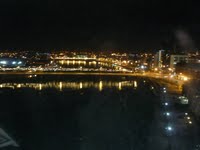Gertrude, our gallant GPS, did a commendable job with her new Irish maps until we reached Beara. The place completely baffled the poor thing. What should have been a simple drive around a modest peninsula quickly deteriorated into "direct routes" through obscure trails and elusive villages that were on the map but probably only appeared every seven years.
But we reached Adrigole at last having met only two other cars in spots where we could pull over and let them pass. We continued on to Castletownbere and stopped for lunch, assured by the owner we’d never find fresher haddock anywhere. He was right.
After lunch, we drove to Eyeries. Sadly, Sue Booth-Forbes, owner, director, and all around wizard of the Anam Cara Writer’s and Artist’s Retreat, was away on a family matter, but we viewed the house, Coolagh Bay, and the town. Only the occasional mooing of cows disturbed the peace. I wished we could linger and walk on the bogs, but the afternoon was fading fast. Perhaps we'd see the rest of the peninsula another time.
The next day we stayed in town for a walk in Killarney National Park. Fine blue skies and warmer temperatures graced our stroll to Ross Castle. The last time we’d seen the castle, scaffolding covered most of it. The renovations are complete,
That evening, we attended the traditional Irish music festival that had been our excuse to visit Ireland this time. After three great concerts, we returned to our hotel room to pack.
-768672.jpg)
Gertrude got us safely back to Limerick the next afternoon. We strolled into town, and I picked up a few books for writing researc h. I nearly shrieked when I saw The Mammoth Book of Irish Romance, the new anthology containing a story I wrote, in one of the bookstores!
h. I nearly shrieked when I saw The Mammoth Book of Irish Romance, the new anthology containing a story I wrote, in one of the bookstores!
Our hotel room overlooked the Shannon River, beautiful at night. Our flight to Boston wouldn’t leave until the following afternoon, but I was already wondering how soon I could return.
Our hotel room overlooked the Shannon River, beautiful at night. Our flight to Boston wouldn’t leave until the following afternoon, but I was already wondering how soon I could return.
